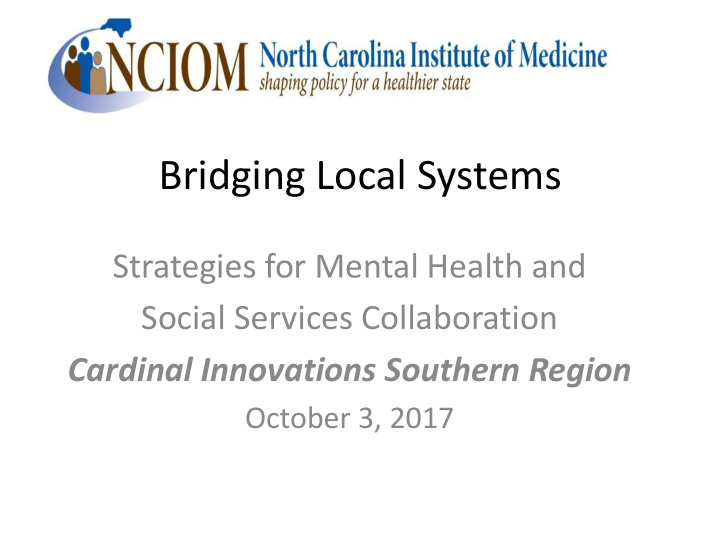



Bridging Local Systems Strategies for Mental Health and Social Services Collaboration Cardinal Innovations Southern Region October 3, 2017
Sponsors • NC Institute of Medicine • The Duke Endowment • The NC Department of Health and Human Services and its Divisions of – MH/DD/SAS – Social Services – Aging and Adult Services – Medical Assistance • The NC Council of Community Programs • The NC Association of County Directors of Social Services
Goals of Bridging Local Systems • Strengthen communication and collaboration between LME/MCOS and DSSs • Improve shared outcomes for shared populations: – Children and families served by child welfare and behavioral health – Adults served by Adult Protective or Guardianship Services Develop metrics to measure collaboration • between DSSs and LME/MCOs
Agenda • Overview and introductions • Review previous meeting • Discuss relevant developments that have happened since the second meeting? • Self-organize follow up and follow through • Make recommendations for the Steering Committee • Evaluate Bridging Local Systems
Cardinal: What can we accomplish? • A clearer understanding of specialty treatment versus any treatment, and improved collaboration to stabilize children and families waiting for appropriate specialty treatment. • Improved collaboration in the context of competing agendas: – DSSs are expected to reduce multiple placements and promote placement stability – MCO’s are expected to provide least restrictive services which may result in multiple moves (e.g., child in PRTF steps down to level II, then level I, then home reunification).
Cardinal: What can we accomplish? • Improving understanding of Cardinal’s responsibility to review medical necessity – A Comprehensive Clinical Assessment (CCA) recommending a level of care is not sufficient – The CCA must include or be supplemented by supporting clinical justification for the interventions and corresponding level of care
DSS: What can we accomplish? • Build on the strengths of the existing relationship • Consider ways to strengthen collaboration with other public agencies at the county level • The interagency relationship has improved over the past 5-7 years but we still have to argue for services – especially for adults • Child and family teams are not always prepared for the toughest kids.
Your High Priority Issues • Access to timely services and crisis management • Services needs and care coordination • Communication
Some Ideas You Suggested • Over communicate – create routine methods for Cardinal and DSS to frequently touch base when dealing with a crisis. • Create internal “SWAT team” at Cardinal to accelerate the response to crisis referrals • Offer training for referral sources on how to write assessments with the UM perspective in mind • Embed assessors in DSS agencies
Some Ideas continued • Produce online training materials for DSS regarding service definition requirements, referral process, service continua, etc. • Include directory of names and contact information for coordinators and regional managers • Add crisis/respite beds in the region • Expand availability of High Fidelity Wraparound services • Expand availability of “Transitional Living” as a B3 services • Expand use of Trauma-informed independent assessments
Have We Done That? Developments Since the last meeting. • Access to timely services and crisis management • Services needs and care coordination • Communication • Other
Suggestions/Commitments for Future Collaboration • Access to timely services and crisis management • Services needs and care coordination • Communication • Creating metrics to evaluate collaboration between MCO and DSS
Recommendations to the Steering Committee
Evaluation of BLS
Recommend
More recommend